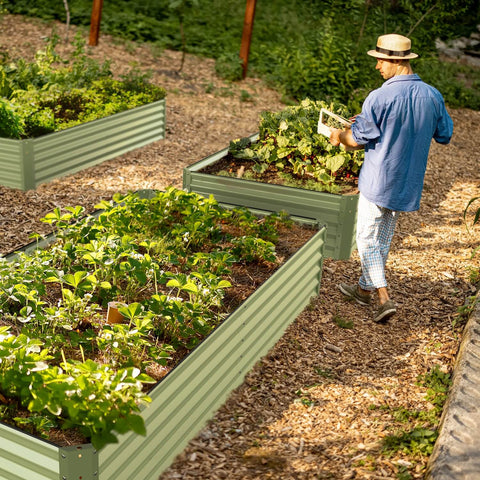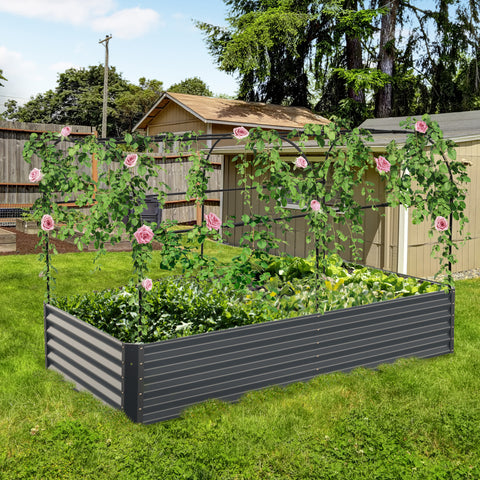Raised vegetable beds reduce the amount of work involved in planting. The following content also has some reference value for raised garden beds.
01 Protect your back
Having raised garden beds can reduce back stress because you don't have to bend so far to reach your plants. With easier access and less potential pain, you can better enjoy the labor of growing, caring for and harvesting vegetables.
Test garden tip: Build raised beds that are at least 12 inches tall. If the walls are slightly below waist level, you can sit on the edge of the soil and harvest your bounty without having to bend over.

02 Grows longer
The soil in which vegetables are grown usually warms up earlier in the spring than the surrounding soil. It also tends to dry out faster, so you can plant cool-season crops faster, extending the growing season and your crop choices.
03 Keep it Clean
Spread mulch on the path between the vegetable beds to keep your feet clean, no matter how wet it gets. Since you won't be walking on a damp garden bed, you can run out and grab a handful of fresh basil for dinner without worrying about tamping down the soil.
04 Overcome bad soil
If your soil is sandy or clay, elevate the vegetable nursery. Instead of fighting poor topsoil, all you need to do is fill your bed with high-quality topsoil and start gardening. Nutrient-rich soil can improve your garden bed, and to keep the soil healthy, continue feeding it with compost and other organic matter.
05 Reduce Weeds
Once your seedbed is filled with fresh soil, cover the surface with an inch or two of mulch. This reduces all weeds (including those in the weed ID guide), reduces competition for nutrients, and preserves moisture.
06 Stop the invasion of grass
Turf grass, with spreading roots, often seeps into a standard vegetable garden and becomes a serious weed. When you build raised beds, nearby sod won't spread onto your vegetable crops, and your garden will stay healthy and happy.
07 Prevention of Pests
Even up in the garden, small animals like rabbits and moles can make a mess of your crops. There are many ways to get rid of pests in your garden, and one way to do that is with taller beds. Design and build walls at least four feet high to deter these intruders.

08 Make your garden more attractive
Set up a series of small raised garden beds in neat rows or patterned areas, and you'll end up with the most visually appealing vegetable patch on your block. Simply giving your raised bed an aesthetic touch will make your neighbors admire it.
09 Never again
Raised vegetable garden beds provide a healthier environment for beneficial microbes and earthworms because there is no human traffic to tamp down the soil.
10 Keep vegetable beds narrow
Set up raised beds so that you can easily reach the middle from either side. Most raised gardens are four feet wide, as the average person can easily reach around two feet.
11 Place raised beds correctly
In your vegetable planting plan, leave enough space between the beds so that you can easily maneuver the wheelbarrow to add soil, harvest, lay mulch, or other activities. Likewise, if you have grass paths between your planting beds, make sure you have enough room for the mower to run comfortably.
12 Use durable materials
When choosing materials for your elevated bed, choose wood that is resistant to rot, such as cedar or redwood. Or choose other materials such as brick, stone, or even concrete so you don't need to rebuild.
13 Add decorative elements to the garden
Seedbed vegetable garden designs can be attractive landscape features. Decorate them with details to add style to their utilitarian form. For example, put hats on the corner posts or paint the wood frame a color that matches your house.
14 Come up with a pattern for the bed
Raised vegetable garden beds are often arranged in squares or rectangles parallel to each other, but you can add some fun to your landscape by arranging the beds in different geometric shapes or patterns. For example, lines that mimic the architectural features of your home. Whatever shape you design, remember to give yourself room to move around and extend comfortably into your bed.

15 Increase the height of the vine
Include trellises, obelisks, or garden plans in your planted beds. Buy or build one or two to grow grape crops such as peas, beans, cucumbers and tomatoes. The extra height gives visual drama to your planting, especially if most of your crops are relatively low.
16 Raised vegetable garden plan
Having a plan of action is ideal in any situation, even a vegetable garden. Check out some vegetable garden plan ideas and learn how to make one yourself.









